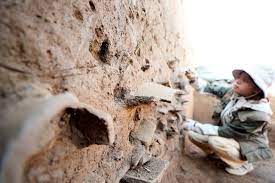Ancient pottery, kilns and wells unearthed in north China ruins

Shijiazhuang: A large number of pottery objects, kilns and pottery-making tools dating back about 2,000 years have been unearthed in the ruins of an ancient city in north China’s Hebei Province, providing further evidence for the study of the pottery industry during the Han Dynasty (202 BC-220 AD).
The finds were made during the fourth excavation of the Bairen Town site in the city of Xingtai starting in mid-August, when more than 200 relics of various types including rammed earth, ash pits, house ruins, wells and pottery kilns were discovered in an area of about 400 square meters.
The ruins of Bairen Town are relatively well-preserved, covering an area of four square kilometers. The existing city walls have a circumference of about 8,000 meters, with some sections standing six to seven meters tall.
The excavations were conducted over almost four months by staff from the Renmin University of China, the Hebei institute of cultural relics and archaeology and the Xingtai cultural relics protection and research center. Archaeologists have previously conducted three excavations there, in 2016, 2018 and 2022.
According to Li Meitian, director of the Department of Archaeology and Culture at the Renmin University, who led the excavation, most of the relics found this time were from the Han Dynasty, which proved that “during that period, Bairen Town was very prosperous and populous.”
Archaeologists also discovered a few cultural relics from the Warring State Period (475-221 BC), the Tang Dynasty (618-907) and later, which he said “could offer a deeper and more thorough understanding of the development and evolution of Bairen Town.”
Li noted that the pottery utensils and kilns unearthed this time showed that the area might have been a major pottery-producing quarter.
“From different layers of relics in the city ruins we know that Bairen Town was used for a long time. It had been already in use during the Warring State Period, and the Han Dynasty saw the peak of its prosperity,” he said.
The excavations are of great significance for further research and discussion of urban ecology from the pre-Qin period to the Han Dynasty in northern China, Li added.





